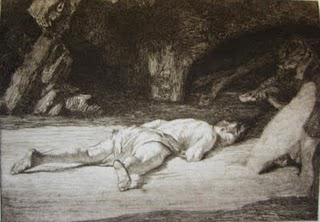 Marcel Roux, L'échouéeEtching, pre-1914 (published by Byblis, 1923)
Marcel Roux, L'échouéeEtching, pre-1914 (published by Byblis, 1923)L'échouée was published alongside a moving essay by Marcel Roux's close friend Justin Godart, "Marcel Roux: graveur Lyonnais". Godart mentions three commissions for interpretative etchings from the Chalcographie du Louvre: Rembrandt's L'ange quittant la famille de Tobie and Le boeuf, and Botticelli's Venus. Roux was evidently not best pleased about the Venus (which he may never have executed) , expressing a preference for Rembrandt's Le bon Samaritain. I had thought until now that Marcel Roux's activity as an interpretative etcher was essentially confined to Rembrandt, whose etchings first inspired him and whom he described as the "Maître de ma jeunesse". But now I have acquired a series of twelve further interpretative etchings by Roux, which show a hitherto obscure side of his prodigious talent. These works date from 1911, and interpret paintings by Delacroix (including a bon Samaritain), Corot, Millet, and Daumier. Two of them (Corot's Baigneuse and La femme au tambourin) are on the Marcel Roux website, but unidentified. They come from what I believe must be the last great work to be illustrated with such etchings, the impossibly lavish exhibition catalogue Vingt Peintres du XIXe Siècle: chefs d'oeuvre de l'École Française. This was commissioned, printed, and published by Galerie Georges Petit. There is a text by Léon Roger-Milès, and 150 original etchings. The commissioning of the artists and art direction of the project appears to have been entrusted to Charles Waltner, so the general standard is very high, but the etchings by Marcel Roux are without doubt the stars of the show. There is nothing timid or restrained about them. Roux's mark-making is bold and vigorous, and exudes a sense of confidence. The plates are deeply-bitten, and the blacks are coal-black. Flicking through the pages there's no need to read the printed credit to recognize another Roux: they simply sing off the page.
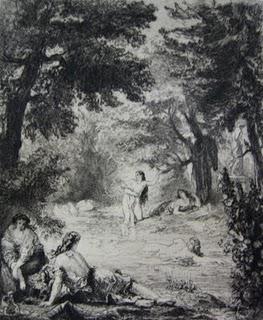 Eugène Delacroix, Femmes turques au bainEtching by Marcel Roux, 1911
Eugène Delacroix, Femmes turques au bainEtching by Marcel Roux, 1911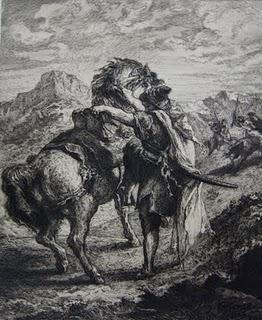 Eugène Delacroix, Arabe montant à chevalEtching by Marcel Roux, 1911
Eugène Delacroix, Arabe montant à chevalEtching by Marcel Roux, 1911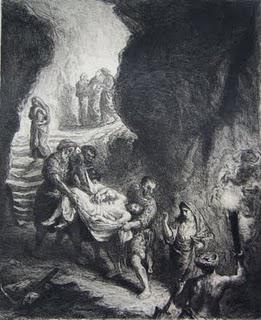 Eugène Delacroix, La mise au tombeauEtching by Marcel Roux, 1911
Eugène Delacroix, La mise au tombeauEtching by Marcel Roux, 1911 Eugène Delacroix, L'éducation d'AchilleEtching by Marcel Roux, 1911
Eugène Delacroix, L'éducation d'AchilleEtching by Marcel Roux, 1911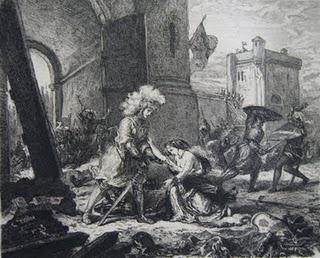 Eugène Delacroix, La délivrance de la princesse OlgaEtching by Marcel Roux, 1911
Eugène Delacroix, La délivrance de la princesse OlgaEtching by Marcel Roux, 1911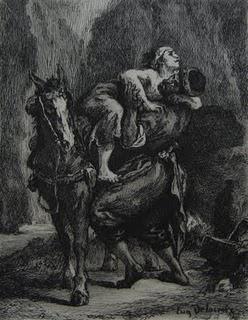 Eugène Delacroix, Le bon SamaritainEtching by Marcel Roux, 1911
Eugène Delacroix, Le bon SamaritainEtching by Marcel Roux, 1911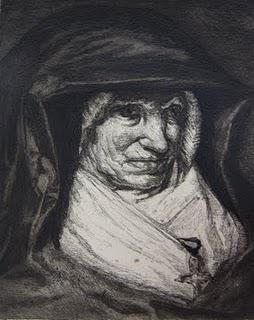 Eugène Delacroix, Tête de vieille femmeEtching by Marcel Roux, 1911
Eugène Delacroix, Tête de vieille femmeEtching by Marcel Roux, 1911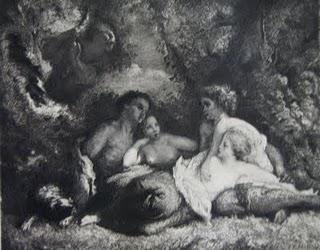 Jean-François Millet, Le reposEtching by Marcel Roux, 1911
Jean-François Millet, Le reposEtching by Marcel Roux, 1911 Jean-François Millet, La fuiteEtching by Marcel Roux, 1911
Jean-François Millet, La fuiteEtching by Marcel Roux, 1911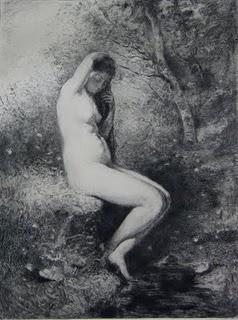 Camille Corot, BaigneuseEtching by Marcel Roux, 1911
Camille Corot, BaigneuseEtching by Marcel Roux, 1911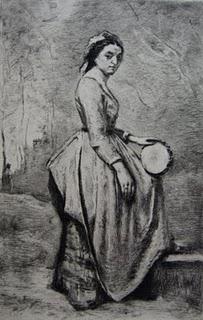 Camille Corot, La femme au tambourinEtching by Marcel Roux, 1911
Camille Corot, La femme au tambourinEtching by Marcel Roux, 1911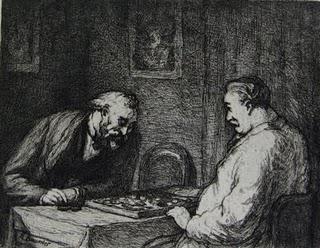 Honoré Daumier, Une partie de damesEtching by Marcel Roux, 1911
Honoré Daumier, Une partie de damesEtching by Marcel Roux, 1911Given Marcel Roux's deeply religious sensibility, it comes as no surprise that he should respond so passionately to the Biblical subjects of La mise au tombeau and Le bon Samaritain, and his eye for social satire was well suited to Daumier, but I do find myself surprised and touched by the tenderness of the two etchings after Millet; this is a note not sounded in Roux's own work. Of the dozen etchings, I think the most completely successful is L'éducation d'Achille, which strikes me as a very powerful treatment of a difficult subject. The etchings were printed on thick BFK Rives wove paper, in an edition of 650 copies, of which these are from no. 324. I suspect the first 50 copies were printed on Japon, though this is not explicitly stated.

